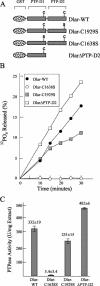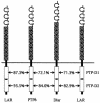Functions of the ectodomain and cytoplasmic tyrosine phosphatase domains of receptor protein tyrosine phosphatase Dlar in vivo
- PMID: 12972609
- PMCID: PMC193937
- DOI: 10.1128/MCB.23.19.6909-6921.2003
Functions of the ectodomain and cytoplasmic tyrosine phosphatase domains of receptor protein tyrosine phosphatase Dlar in vivo
Abstract
The receptor protein tyrosine phosphatase (PTPase) Dlar has an ectodomain consisting of three immunoglobulin (Ig)-like domains and nine fibronectin type III (FnIII) repeats and a cytoplasmic domain consisting of two PTPase domains, membrane-proximal PTP-D1 and C-terminal PTP-D2. A series of mutant Dlar transgenes were introduced into the Drosophila genome via P-element transformation and were then assayed for their capacity to rescue phenotypes caused by homozygous loss-of-function genotypes. The Ig-like domains, but not the FnIII domains, are essential for survival. Conversely, the FnIII domains, but not the Ig-like domains, are required during oogenesis, suggesting that different domains of the Dlar ectodomain are involved in distinct functions during Drosophila development. All detectable PTPase activity maps to PTP-D1 in vitro. The catalytically inactive mutants of Dlar were able to rescue Dlar(-/-) lethality nearly as efficiently as wild-type Dlar transgenes, while this ability was impaired in the PTP-D2 deletion mutants DlarDeltaPTP-D2 and Dlar(bypass). Dlar-C1929S, in which PTP-D2 has been inactivated, increases the frequency of bypass phenotype observed in Dlar(-/-) genotypes, but only if PTP-D1 is catalytically active in the transgene. These results indicate multiple roles for PTP-D2, perhaps by acting as a docking domain for downstream elements and as a regulator of PTP-D1.
Figures








Similar articles
-
The second catalytic domain of protein tyrosine phosphatase delta (PTP delta) binds to and inhibits the first catalytic domain of PTP sigma.Mol Cell Biol. 1998 May;18(5):2608-16. doi: 10.1128/MCB.18.5.2608. Mol Cell Biol. 1998. PMID: 9566880 Free PMC article.
-
Kinetic analysis of two closely related receptor-like protein-tyrosine-phosphatases, PTP alpha and PTP epsilon.Eur J Biochem. 1997 May 1;245(3):693-700. doi: 10.1111/j.1432-1033.1997.00693.x. Eur J Biochem. 1997. PMID: 9183007
-
Modulation of catalytic activity in multi-domain protein tyrosine phosphatases.PLoS One. 2011;6(9):e24766. doi: 10.1371/journal.pone.0024766. Epub 2011 Sep 13. PLoS One. 2011. PMID: 21931847 Free PMC article.
-
Gathering STYX: phosphatase-like form predicts functions for unique protein-interaction domains.Trends Biochem Sci. 1998 Aug;23(8):301-6. doi: 10.1016/s0968-0004(98)01241-9. Trends Biochem Sci. 1998. PMID: 9757831 Review.
-
Protein Tyrosine Phosphatase Receptor-type Q: Structure, Activity, and Implications in Human Disease.Protein Pept Lett. 2022;29(7):567-573. doi: 10.2174/0929866529666220511141826. Protein Pept Lett. 2022. PMID: 35546749 Review.
Cited by
-
Lar maintains the homeostasis of the hematopoietic organ in Drosophila by regulating insulin signaling in the niche.Development. 2019 Dec 23;146(24):dev178202. doi: 10.1242/dev.178202. Development. 2019. PMID: 31784462 Free PMC article.
-
Complex interactions amongst N-cadherin, DLAR, and Liprin-alpha regulate Drosophila photoreceptor axon targeting.Dev Biol. 2009 Dec 1;336(1):10-9. doi: 10.1016/j.ydbio.2009.09.016. Epub 2009 Sep 18. Dev Biol. 2009. PMID: 19766621 Free PMC article.
-
Extracellular regulation of type IIa receptor protein tyrosine phosphatases: mechanistic insights from structural analyses.Semin Cell Dev Biol. 2015 Jan;37:98-107. doi: 10.1016/j.semcdb.2014.09.007. Epub 2014 Sep 16. Semin Cell Dev Biol. 2015. PMID: 25234613 Free PMC article. Review.
-
Structural basis for extracellular cis and trans RPTPσ signal competition in synaptogenesis.Nat Commun. 2014 Nov 11;5:5209. doi: 10.1038/ncomms6209. Nat Commun. 2014. PMID: 25385546 Free PMC article.
-
An RNAi Screen To Identify Protein Phosphatases That Function Within the Drosophila Circadian Clock.G3 (Bethesda). 2016 Dec 7;6(12):4227-4238. doi: 10.1534/g3.116.035345. G3 (Bethesda). 2016. PMID: 27784754 Free PMC article.
References
-
- Allard, J. D., R. Herbst, P. M. Carroll, and M. A. Simon. 1998. Mutational analysis of the SRC homology 2 domain protein-tyrosine phosphatase Corkscrew. J. Biol. Chem. 273:13129-13135. - PubMed
-
- Bateman, J., R. S. Reddy, H. Saito, and D. Van Vactor. 2001. The receptor tyrosine phosphatase Dlar and integrins organize actin filaments in the Drosophila follicular epithelium. Curr. Biol. 11:1317-1327. - PubMed
-
- Bateman, J., H. Shu, and D. Van Vactor. 2000. The guanine nucleotide exchange factor trio mediates axonal development in the Drosophila embryo. Neuron 26:93-106. - PubMed
-
- Bilwes, A. M., J. den Hertog, T. Hunter, and J. P. Noel. 1996. Structural basis for inhibition of receptor protein-tyrosine phosphatase-α by dimerization. Nature 382:555-559. - PubMed
Publication types
MeSH terms
Substances
Grants and funding
LinkOut - more resources
Full Text Sources
Molecular Biology Databases
